Money Management Techniques in Forex Trading
Forex Trading for Beginners • Step by Step
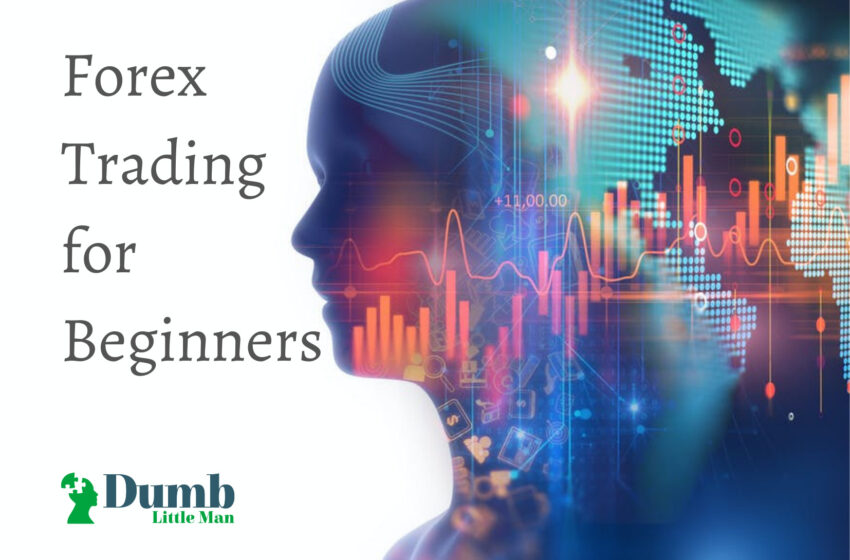
Learning forex trading for beginners can seem like a huge challenge. This is partly due to the unrealistic expectations many come into the forex scene with. However, what is more, disturbing is the lack of a comprehensive explanation of the basics to newcomers. Many of them, therefore, end up investing in the information they either do not need or understand.
Forex, or foreign exchange, involves exchanging currencies to benefit from the difference in exchange rates. Foreign exchange is what makes international trade, commerce, and tourism possible. As of April 2019, the Bank for International Settlements reports that nothing less than $6.6 trillion is traded every day through forex.
The good news is that many of the basic rules in forex remain unchanged despite trading in different markets. We have prepared this comprehensive guide as a way out for those interested in trading forex.
Below, you will find everything you need to trade forex, including information about forex markets, forex trading strategies, how to trade, terminologies, etc.
Let's jump right in!
Table of Contents
- What is Forex Trading?
- History of the Forex Market
- Overview of Forex Trading
- The Forex Trading Systems
- Intraday Trade
- Scalp Trade
- Position Trade
- Swing Trade
- Terminologies for Trading Forex
- 1. Spot Forex
- 2. Bull Market
- 3. Bear Market
- 4. Spread
- 5. Pip
- 6. CFDs
- 8. Margin
- 9. Leverage
- 10. Day Trading
- 11. Forex Account
- 12. Bid/Ask Price
- 13. Beta
- 14. Exchange
- 15. Broker
- Forex Charts Reading for Beginners
- Line Charts
- Bar Charts
- Candlestick Charts
- Foreign Exchange Trading for Beginners
- Forex Trading Tutorial
- 1. Learn Chart Reading Methods
- 2. Employ Established Trading Strategies
- 3. Use Reliable Trading Systems
- Other Tips for Foreign Exchange Trading
- 1. Learn about the forex market
- 2. Develop a plan and stick to it
- 3. Test your strategies and practice
- 4. Follow numbers and market conditions
- 5. Be aware of limits
- 6. This is no place for emotions
- 7. Go slowly and grow steadily
- 8. Set up a trading account
- Frequently Asked Questions
- Where can I trade forex?
- Is forex trading good for beginners?
- How volatile is forex?
- Is forex a regulated market?
- Which currency can a beginner trade?
- How do I start forex trading for beginners?
- Final Thoughts
-
- Like this Article? Subscribe to Our Feed!
-
What is Forex Trading?
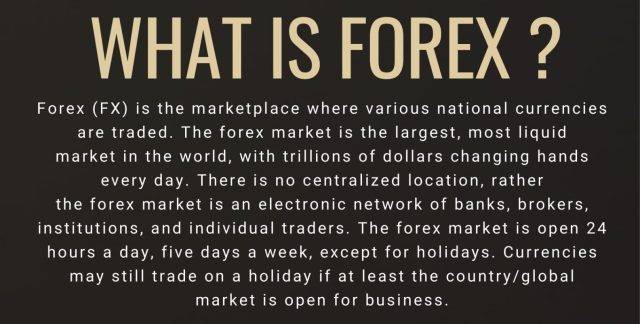
Forex trading is the process of exchanging national currencies and it is carried out in the global marketplace known as the forex market. Currencies are essential for conducting local or international trade, and for trade to happen between two nations, international currencies and hence, foreign exchange has to be involved.
For instance, if someone who lives in France wants to buy a hamburger from a restaurant in the US, they have to pay in US dollars (USD), which is a foreign currency. Therefore, they need to know the price for a hamburger and exchange their euros to get the amount in USD that buys the hamburger.
It is the same if a UK national wants to go on a tourist visit to see the Eiffel Tower in France. They need to exchange pounds sterling to get the adequate locally accepted euros. The forex market always involves currency pairs. In the first example above, the currency pairs involved are euros and US dollars, while it is pounds sterling and euros for the second.
However, a central marketplace does not exist for trading foreign exchange. Instead, trading a particular currency is carried out electronically through computers. Forex traders all over the world buy and sell currencies via multiple market openings worldwide.
Forex markets are always open five days a week. The major currency trading centers include New York, London, Hong Kong, Paris, Tokyo, Frankfurt, Sydney, Singapore, and Zurich. These forex markets feature constantly changing prices and make forex trading possible at any time of the day.
History of the Forex Market
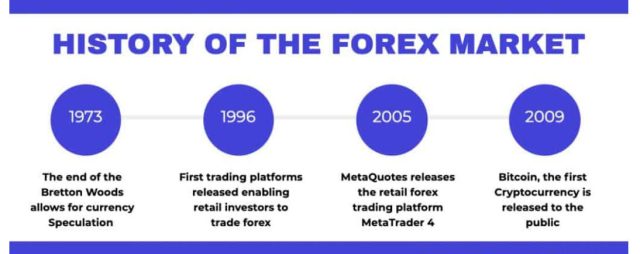
Basically, the concept of the forex market has existed for many centuries. History made us understand that people pay for goods and services with currencies they bought and goods they bartered. However, the modern-day forex market is slightly different.
After the Second World War, economies all over the world were in a state of confusion and disorder. To address this issue, major governments in the Western world created a system, known as the Bretton Woods System, to make the economy stable.
It worked as exchange rates were stable for some time until some economies started growing faster and evolving than others. The system, at this point, could no longer deliver its purpose. In 1971, the Bretton Woods accord collapsed, and a different era of currency valuation was ushered in.
Some currencies began growing, depending on the rates of demand and supply. Determining the correct exchange rates was initially difficult, but technological advances eased things along the way, with foreign exchange services.
At that time, big investment and commercial banks could trade forex for clients. However, speculative opportunities also existed for certain currency pairs for professional investors. They can either make profits from exchange rate changes or earn from differences in currency pairs.
Among the most popular currency pairs were the Japanese yen and British pounds (JPY-GBP) during the early 2000s. This was due to the huge difference between the interest rates. Investors gained from buying the British pounds with a high-interest rate and shorting the Japanese yen, in a strategy known as "carry trade."
However, forex trading was challenging for individual traders, since they could not generate the huge capital needed. By the 1900s, this changed as we started seeing computers and the internet. Banks also started organizing trading platforms that gave real-time quotes clients can use to trade forex.
Trading platforms have existed through the internet since then for individual traders. Now, anybody can trade forex in small amounts (from 1000 units) through the banks or these web-based platforms created by retail forex brokers.
Overview of Forex Trading
The forex market is the sole market in the world where trading goes on nonstop. It used to be a concentration of huge backs and institutional firms that helped clients carry out trades. However, the market has recently grown into a more retail-based venture. Both investors and traders are active participants, holding parts of it.
One interesting point to note within the forex space is the absence of physical buildings or locations where market trades happen. In its place, there are computer networks and connections that function as trading terminals. Those who participate in the forex market include retail investors, financial institutions, commercial banks, and investment banks.
The forex market may be considered less transparent than many financial markets. This is because currency trading happens over the counter with non-mandatory disclosures. Institutional firms offer huge pools of liquidity within the market.
You may think that the economic positions of countries have a huge impact on the prices in the market but that is not necessarily what happens. In 2019, a survey was carried out which discovered that the prices of currencies were most impacted by the financial institutions' actions.
Forex can be traded in three ways. They include the forwards, spots, and futures.
The spot market is the biggest forex trading method since its trades occur through the basic assets of the other market types, i.e. futures and forwards. The volume of trade happening within the futures and forwards market used to be more than that of the spot. However, when electronic trading came around and brokers saw a rapid increase, this changed and the spot market received a huge boost.
Today, most of those who talk about the market actually have the spots market in mind. Futures and forwards markets are more common with institutions that want to keep their forex risks to a future time.
The spot market operates in a simple way. Since it is the location for buying and selling currencies at their specific trading price, it also relies on the demand and supply factors. Estimating the prices is subject to a host of factors like economic standing, interest rates, local and international politics, predictions, etc.
When a deal is settled, it is called a "spot deal." This is referring to a transaction with agreement from both ends for one of them to deliver an agreed amount of a specific currency to the other and for the other party to send deliver another currency based on the exchange rate of the currency pair. Payment is usually done in cash and settlements are carried out in two days.
The other types of markets are known as forwards and futures. Forwards involves a private arrangement by two entities to trade a currency in the future at a specified price. Meanwhile, futures involve an arrangement to deliver a currency in the future at a specified price.
These two are different from the spot market because they do not trade on actual currencies. What they trade on are contracts representing claims around specific currencies, specific unit prices, and settlements at a future date
You can buy and sell contracts within the forwards market and the agreement terms would be set between you and the other party. However, the futures market operates with standard sizes and settlement dates within the market.
The futures market is regulated in the United States and you may find similar regulatory agencies elsewhere. The contracts are operated with all details about the trade laid out. Some of the details include the number of units, dates for delivery and settlement, basic increments for prices, etc.
Irrespective of the nature of contracts for futures and forwards, both are binding. After the expiration of the contracts, they are also usually settled with cash. Another interesting part of these contracts is that you can also buy and sell them (the contracts) prior to expiration.
These markets are ideal for getting more protection from risk for those who trade currencies. In fact, big financial institutions all over the world use these contracts to get protection from future fluctuations and exchange rate irregularities. Although, these markets are also the important ones patronized by speculators.
The Forex Trading Systems
There are a number of trading systems beginners can use when trading forex. The good news is that large corporations, banks, other financial organizations, and investors have traded forex for many years. Their actions have helped to create several strategies that a beginner can take advantage of.
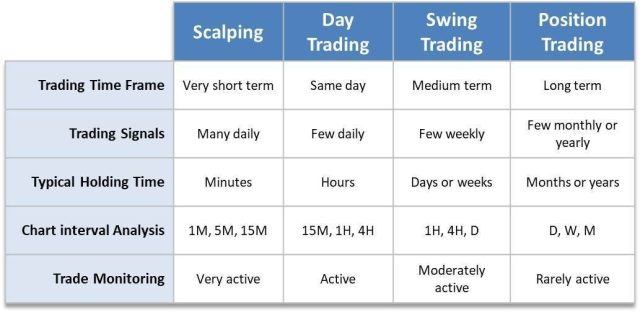
While it may be challenging to commit it all to memory immediately, you can try them one after the other and come back to this guide for clarifications.
Short trade and long trades are the primary trade types. For the short trade, it is simply speculating on the price of a currency pair to decrease at a time to come. So, they sell before that happens. The long trade is where traders invest in a currency pair with speculation that it will increase in value, allowing them to profit from the difference.
However, traders may employ several strategies that depend on technical analysis to make fine adjustments to the trading strategies. Below are some of the most common strategies in forex trading for beginners.
Intraday Trade
These are conservative short-term trades that beginners can start with. Holding positions and liquidations occur within a day. Intraday trades are based on either the one-hour price trend or the four-hour trend. Openings are in one to four hours and are usually related to the main forex market sessions.
The profits are not huge but you can make accumulating profits that can be sizeable at the end of the day. However, a trader needs to be skilled in technical analyses and understand how technical indicators work to take full advantage of intraday trades.
Scalp Trade
Also known as currency scalping, this trading strategy involves trading a currency pair in short periods, typically seconds, minutes, or a few hours. This hands-on strategy has limitations to the number of pips you can trade. Therefore, the profits are small.
However, scalp trades are also cumulative, which means they let you make numerous small profits that accumulate to a sizeable amount when the day ends. They are usually traded on the currency pairs with high liquidity at a time when the foreign exchange market is very busy. That is because they deal with price change certainty.
Position Trade
Position trade is a long-term trade where the trader keeps the currency for an extended length of time, such as many months or years. You do not have to invest in too much analysis for this kind of trade. All you need is fundamental knowledge since the trade usually has well-grounded bases.
Swing Trade
Swing trade is medium-term, with trades spanning only a few weeks or days. It is ideal for traders who want to trade part-time to support their normal day jobs. Swing trade relies on huge price movements that a trader can maintain for some days.
This kind of trade works during harsh economic circumstances or when governments make major announcements. They also do not require continuously following market trends. You only need minimal technical analysis as well as political and economic developments, especially how they affect the currency market.
Terminologies for Trading Forex
Any forex for beginners guide would not be complete with a list of important terms you're going to come across throughout your journey. Knowing these helps you understand other aspects of forex trading.
Below are the most common terms to assist you to learn forex trading.
1. Spot Forex
This is a forex trading type that involves trading actual currency. For instance, a forex trader can buy a particular amount of US dollars to exchange for pounds sterling. The trader profits by exchanging the pounds sterling for US dollars again when US dollars increases in value. The trader will have received more than he bought the original US dollars.
2. Bull Market
The bull market is when the prices of all currencies increase. It usually signifies an upturn in markets and comes as a result of good news about the worldwide economy. When a stock experiences a period with rising prices, it can be referred to as a bullish market.
3. Bear Market
This is the opposite of a bull market and is when all currencies decrease in price. It signifies a downturn in stock prices and results from a falling economic situation or financial crisis. A particular stock will be referred to as bearish if its price falls quickly.
4. Spread
This is the difference between the bid price and the asking price of a currency pair. The spread of most trading currency pairs is usually low but could also be high, especially when the pairs trade less often. Forex trade is profitable when the spread is lower than the currency pair value.
The spread is what a forex broker makes money from since they do not charge commissions on trades. A spread is determined by various factors, including trade size, currency pair demand, and volatility.
5. Pip
The pip, also known as percentage in point, is the unit price of a currency pair. It is equivalent to 0.0001 of the currency price. That means a hundred pips is equal to a cent. However, the value of a pip can vary based on the offer from the forex broker.
6. CFDs
The contract for difference (CFD) is a contract that denotes how financial instruments move. Trading CFDs allows you to take advantage of moving prices rather than trading huge currency amounts directly. You do not have to own any of the assets you trade-in yourself.
Just like forex, CFDs are available in bonds, stocks, penny stocks, indices, cryptocurrencies, and commodities. With CFD, you do not have to purchase any of these but can trade on the price movements.
8. Margin
As you operate a trading account on any trading platform, any money that is retained in the account is known as a margin. It assures the broker that the trader will be responsible for necessary obligations, whether the trade returns positively or not.
Margins vary depending on the balance after forex trades. However, since many forex traders hardly possess an adequate margin for trading forex at high volumes for profit, forex brokers give traders leverage.
9. Leverage
Leverage is a borrowed capital that is used for boosting traders' positions. Its purpose is for multiplying returns and it is quite beneficial in the parts of the forex market, where exchange rates hardly change.
For instance, a trader could trade a currency pair involving Japanese yen and US dollars (JPY-USD), using their own $1000 and a borrowed leverage of $9000. The leverage is provided by a forex broker to improve their bid price.
Hence, this trader would be receiving massive returns if the currency pairs trading goes in the right direction. However, it also comes with huge risks and losses if the currency pairs trade does not come favorably.
As a beginner in forex trading, you should approach leverage with caution by looking at it from both sides. While it may multiply your profit by the ratio of leverage you've utilized, it is also capable of multiplying your loss by the same factor.
10. Day Trading
Day trading is another common strategy within the forex market. It involves buying and selling major currency pairs, exotic currency pairs, or any other currency pair in a day. It is also possible for someone's day-trading currencies to make bids on future performance.
11. Forex Account
This is an account through which forex traders start trading major currency pairs, exotic currency pairs, or any other currency pairs. Forex accounts can be a micro forex account (as much as $1000 per lot), a mini forex account ($10,000), or a standard forex account ($100,000).
12. Bid/Ask Price
The bid, or bid price, is the amount the forex trader wants to pay for each share. This price is positioned against the asking price – the price at which sellers want to sell shares. The difference between both is the spread. When demand is high, bid prices may be greater than the asking price even though it is usually the opposite.
13. Beta
This is a system of measurement that indicates how a stock is doing at price compared to the forex market price. A beta of 2.5 indicates that the stock is moving at 2.5 per 1 point movement of the specific market.
14. Exchange
The stock exchange is the location for trading, with the most common ones being the NYSE (New York Stock Exchange) and NASDAQ (National Association of Securities Dealers Automated Quotations).
15. Broker
This is an organization or individual who assists forex traders to start trading on the forex market via their trading platforms.
Forex Charts Reading for Beginners
When you learn forex trading, the charts are one of the key aspects you should aim to understand. Although you can switch among them, the three options available are explained below.
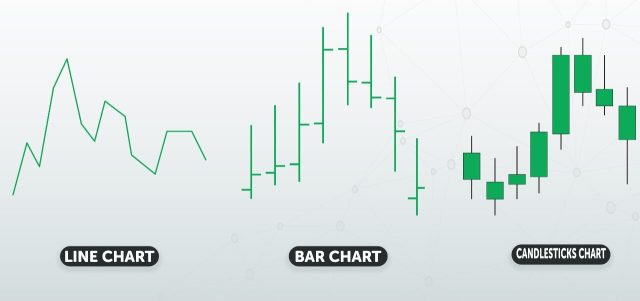
Line Charts
A line chart is a basic chart that connects all closing prices for the current time frame in view. In the daily chart view, this line connects each trading day's close price. Line charts do not offer significant insights aside from identifying larger market trends.
Bar Charts
The bar chart breaks things down further with a bar that represents each period in view. As a result, you can see vertical bars representing the trading a day trade. It is also known as the OLC bar chart because of the values it displays- open, high, low, and close.
You can find a dash that stands for the opening price on the left and the corresponding closing price on the right. The highest point on the bar represents the highest traded market price within the selected period. Meanwhile, the lowest point on the bar represents the lowest traded price within the selected period.
You should also find green bars that are referred to as buyer bars, found higher than the opening price. There are red bars founder lower than the opening price, and they are referred to as seller bars. Within the bar charts, traders can identify how the market is faring and who is in charge between the sellers and buyers.
Candlestick Charts
Candlestick charts have their foundations from bar charts and their use began in the 18th century when the Japanese rice traders employed them. While they also offer values like the open, high, low, and close for a particular period, they also offer more. For instance, they include the 'body' represented by a box between the opening and closing price.
Overall, this type of chart is the most popular since they supply a lot of patterns about price actions for traders to take advantage of. It is also quite visually appealing such that you can view live chats easily.
Foreign Exchange Trading for Beginners
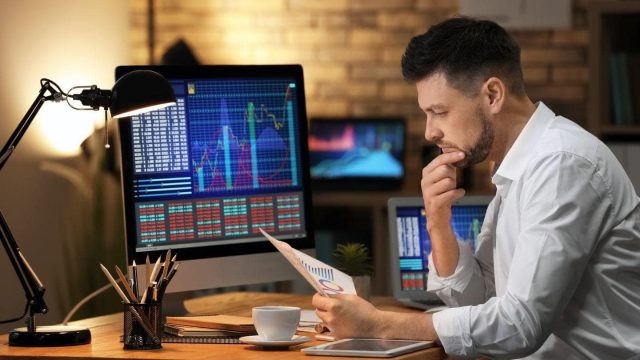
This section of the forex for beginners' guide details the factors you should be aware of before trading. The first thing to decide is the trade type you'd like to make between the long and sort types. You also have to decide the size and cost. Each term is explained below.
There are two kinds of trade based on whether you buy or sell with the expectation that the currency value increases or decreases. A long trade is when you buy a currency hoping that its value increases and you can profit from the difference in the purchase price and sale price.
On the other hand, traders may sell a currency hoping that it decreases in value and they can profit when they buy again at a lower price. Other things you should take note of are both the ask price and the bid price.
A pair of currencies trade depending on the exchange rate of their exchange rate at the time. Since brokers can profit from the buying and selling prices difference of the currency pair, also known as the spread. A specific currency can move based on either the current liquidity or demand and supply.
When a currency pair is high in demand and supply within the forex market, that means it has high liquidity. Meanwhile, the demand and supply are generated by traders, banks, importers, exporters, and companies.
Major currency pairs, like EUR/USD, usually have high liquidity and provide short-term trade opportunities. Although minor and exotic currency pairs also present decent opportunities, especially for those who are knowledgeable about them.
Forex Trading Tutorial
Ezekiel Chew is a top forex trader, founder of Asia Forex Mentor, and the chief instructor for the forex trading company's proprietary One Core Program. He has over two decades of experience teaching bank employees and beginner forex traders how to make six-figure forex trades.

His One Core Program is one of the best trading tutorials beginners can enrol in. As part of his highly effective forex trading strategies that will guarantee you success, below are his top tips that constitute investment advice in trading forex.
Ezekiel is a firm believer in three essential strategies.
1. Learn Chart Reading Methods
Reading the charts is an important technique for discovering hidden trade gems. Most professional traders prefer to use price action for their chart reading and this method has proven to be effective over the years.
Being able to read charts equips you with the knowledge to decipher different aspects of the forex market, including why the market moves where it does and the best strategy for taking advantage of the situation.
2. Employ Established Trading Strategies
There are numerous trading strategies but it is best to keep to only the proven ones. You can identify these by confirming if it has been tested and proven to deliver great results consistently. This does not only bring you profits but also keeps you going when things quiet down.
3. Use Reliable Trading Systems
Reliable trading systems are characterized by excellence from all angles. They are adequately equipped with a sound technical aspect of forex trading and allow you to structure your trade in line with the accepted trading style in ways that are proven to deliver.
Many new forex traders believe trading currencies is all about strategies. However, a huge part of successful trading relies on analyzing the system, since it also imparts your trading experience.
Ezekiel's system relies on covering for small losses with big wins. This has been his mantra and a strategy with which he teaches his students. This gives you an ultimate edge, supported by mathematical probabilities and guaranteed to make you a successful currency trader.
You can get more details about Ezekiel's One Core Program by checking out his website.
Other Tips for Foreign Exchange Trading
Currency trading beginners have quite a challenge in front of them. But thanks to the wealth of experience from experienced traders, you too can get trading CFDs and sell currencies to become a top forex trader. Below are the most important trading tips to keep in mind.
1. Learn about the forex market
The forex market is quite vast and you cannot go into it without equipping yourself with adequate knowledge. Avoiding loss requires that you invest some time in education about currency pairs and why currency prices move before you start trading forex.
This could save you from avoidable mistakes within the fx market. It could make a whole lot of difference between losing money rapidly in the starting stages and ending up with profits from the start. You may even want to ask yourself basic questions like why trade forex.
Other knowledge types you should get include market movements, bar charts, trading analysis, technical analysis tools, etc. These may not be the same as a real-life trading experience, but they sure will get you ready.
2. Develop a plan and stick to it
It is never a good idea to show up on the currency market or start forex trading without a plan. Although it is impossible to predict price movements, a strategy will help you stay on track and improve future performance.
Some parameters you can include for determining a plan are your level of risk tolerance, profit goals, and evaluation methods. It is equally essential to stick to the plan you've created and remember forex trading relies both on leveraging and a willingness to risk.
3. Test your strategies and practice
With the free demo accounts, new forex traders can test their strategies on major currency pairs. This gives you an atmosphere like an actual trading day without investing your own funds.
4. Follow numbers and market conditions
After setting up strategies, you also have to pay attention to happenings in the market. One popular method is to analyze financial data and political events that can influence the forex market. Another method uses technical analysis, like Fibonacci retracements, moving averages, etc.
Also, you should keep track of your daily activities after each trading day. Many trading platforms give you this option for those who create retail investor accounts with them. Ensure there is enough cash left in your trading account and that no pending position is left open.
5. Be aware of limits
As much as you want to push on and never give up, it is also important that you set limits for yourself and respect them. There will be losing trades that you need to exit and resist the temptation to go on with. You should also know how much of your own funds you can lose without throwing you into a financial situation you do not want to be in.
6. This is no place for emotions
Forex for beginners can be challenging and a real test of your emotional wellbeing. You're likely going to end up with many questions at some points, and favorable financial markets at other points. Hence, it is vital to keep your emotions in check throughout wins and losses.
7. Go slowly and grow steadily
Consistency is vital in forex trading. You are certainly going to lose money just like every forex trader has. However, maintaining a level head and sticking with a working strategy helps you get hold of the stock market.
Additionally, you need to be aware of your growth. This may require that you change strategies, try other brokers, consult an independent financial advisor, get a trading partner, employ complex instruments, or go back to the forex trading basics.
8. Set up a trading account
Choosing the best forex broker is also essential for a number of reasons. It helps you get a fair market price, gives you a trading platform, helps you with analysis, etc. Thankfully, you don't have to pay a commission since they make their money through pips.
Frequently Asked Questions
Where can I trade forex?
You can trade forex in three places. They are the spots, forwards, and futures markets. The forwards and futures markets are based on the spot market. Hence, the largest and most traded in the spot market.
Is forex trading good for beginners?
The answer to this is down to you but you should be aware that forex trading is done for several reasons, with hedging and speculation being the most well-known. Traders use speculation to profit from rising and falling prices of currencies. Hedging, on the other hand, is a tool used by big companies to stabilize transactions.
How volatile is forex?
Forex is a highly liquid market. That means its volatility ranks below markets, such as real estate. However, certain currencies can still present high volatility, depending on a host of factors like the country's economic, financial, and political status. Therefore, you should put these in mind when trading on any currency.
Is forex a regulated market?
There are regulations on forex in some parts of the world and there aren't in others. Countries that have an advanced system in place have bodies that oversee their forex trades. An example is the United State where the National Futures Association regulates its futures market. Another regulatory agency is the Commodity Futures Trading Commission (CFTC).
The Financial Conduct Authority (FCA) is also in charge of forex regulations within the UK and you can find similar bodies around Europe since it has the largest forex markets. Some other countries like China and India also have restrictions in the type of capital and firms that can participate in trading forex due to a high occurrence of leverage.
Which currency can a beginner trade?
As a beginner, you may want to target the highly liquid currencies, since they have markets ready for them. They also offer good predictability and respond well to events. The most traded currency is the United States dollar, which also features in all but one of the world's seven most liquid currency pairs.
If a currency has low liquidity, it can only be traded in small sizes to avoid huge market movements from the price. You can find this in currencies from developing countries. When you have a pairing between these currencies with a developed country's currency, you get exotic currency pairs.
How do I start forex trading for beginners?
A beginner in the forex market has to start by acquiring the right education about the forex market. It does not have to be anything formal but should be enough to get you up to speed with the related terms and how the market operates. Then, they need to create a strategy as per their risk tolerance and available finances.
Read Also: 10 Best Forex Trading Course
Final Thoughts
That is a comprehensive explanation of forex trading for beginners anywhere in the world. Since forex is traded online, you can bank on the tips and lessons above to get started on your forex trading journey.
If you're looking to make it quick with little funds, the forex market is a good place to begin. More specifically, we would suggest you try out the swing trade or day trade. In case you'd prefer to invest more funds, try long-term forex trading for more profits.
Forex trading for beginners can be quite challenging at first. However, with an open mind, willingness, and this forex trading guide, you're on your way to writing your name among the best forex traders.
Like this Article? Subscribe to Our Feed!

Author: DLM Editor
Life tips and life hacks for happiness and prosperity.
Money Management Techniques in Forex Trading
Source: https://www.dumblittleman.com/forex-trading-for-beginners/

0 Response to "Money Management Techniques in Forex Trading"
Post a Comment